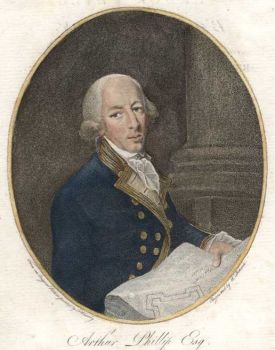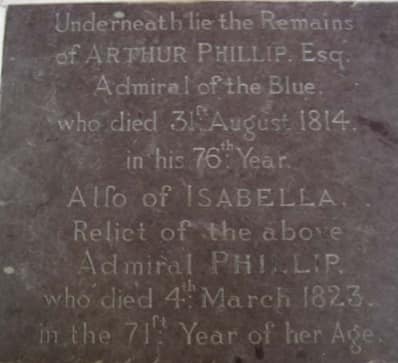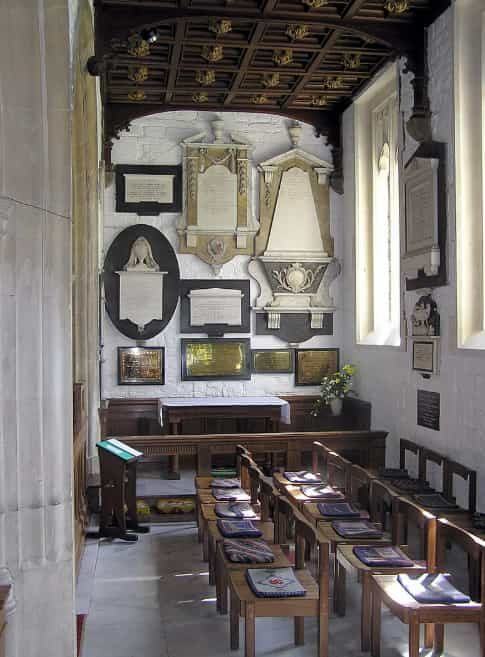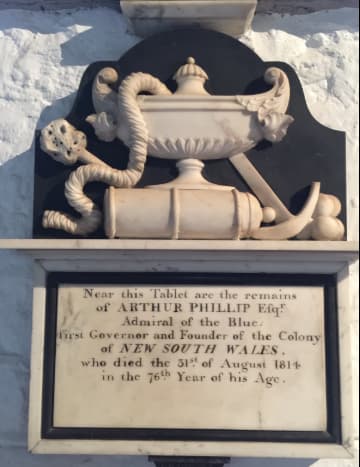Admiral Arthur Phillip
First Governor of Australia
Birth: 11 October 1738, LondonArrival: H.M.S. Supply 1788
Occupation: First Governor of NSW
Marriage (1): Margaret m. 1763
Marriage (2): Isabella Whitehead m. 1794
Death: Bath, 31 August 1814

Arthur Phillip was born on 11 October 1738 in the parish of Allhallows, ward of Bread Street, London, the second child of Jacob Phillip, a language teacher who came to London from Frankfurt, and Elizabeth, nee Breach.[1] Arthur's sister Rebecca was christened at Allhallows on 26th June 1737. [2]
After a distinguished and diverse career Admiral Arthur Phillip was appointed first Governor of New South Wales. The story of his governorship is well noted: from the arrival of the First Fleet at Botany Bay on 18 January 1788; the decision to move the settlement on discovering that it was not suitable; the founding of Port Jackson and the proclamation of the settlement at Sydney Cove on 26 January 1788.
In New South Wales in April 1790, Governor Phillip became ill and applied for a year's leave of absence. He renewed the request on the 25th March, 1791, again on the grounds of ill-health. On the 21st November, 1791, he wrote to Lord Grenville, requesting permission to resign so that he might return to England, 'in hopes of finding that relief which this country does not afford'.
Having spent almost five years in the colony, he eventually sailed for England on the Atlantic on 11th December, 1792, leaving Major Grose, the Lieutenant-Governor, in charge. He took with him many specimens of plants and animals and also two young aboriginal people Bennelong and friend Yemmerrawanne.
Soon after returning to England in July 1793 Arthur Phillip formally resigned Governorship on the grounds that he suffered from a complaint which could not be properly treated in the Colony. [3]
Arthur Phillip's Grave
Arthur Phillip died in August 1814, twenty-one years after returning to his homeland. He was buried at St. Nicholas Church, Bathampton, however the actual site of his grave was overlooked for many years. Below are extracts from various newspapers detailing the discovery of a plaque in the floor inside the Church.....Extract from The Times in the Morning Post (Cairns) 17th February 1898 -
The Father of the Pacific
The Rev. Lancelot J. Fish, Vicar of Bathampton, Bath, writes to the Times as follows: 'A discovery of some interest has just been made in our parish church, which I know not how to make known to those most interested, unless it is by means of the publicity your ubiquitous columns alone command. For some time the authorities of New South Wales have been searching for the burial place of Commander Phillip founder of New South Wales, and, as many hold the 'Father of Australia'.Phillip was known to have died in Bath which he retired to soon after his withdrawal from the service, and a search in the city of Bath and the neighbouring villages has resulted in the discovery, first, of the fact that Phillip was buried in this parish and, secondly of his grave which lies in the floor of Bathampton Church. It bears this inscription:
Underneath lies the remains of Arthur Phillip Esq., Who died 31 August 1814 In his 76th year.

'Here, you will observe is no allusion to his great work and naturally at that time, though only 13 years before her Majesty came to the throne, his services to the state were not recognised as being worthy of mention. On the tomb of the man himself there is absolutely no reference to the fact that he sowed where others are so abundantly reaping. It is not often that tombstones are guilty of suppression in this sense; in fact, tombstones are often so regarded as a race of barefaced perjurers that it is a comfort to find that they can sometimes lie in a direction other than the usual one.
I have written to various authorities in New South Wales announcing the fact of the grave's existence and expressing the hope that in some way, the colony will worthily mark the resting place of this maker of Greater Britain; but there must be many Australian resident in England, or visiting home, who will be glad to know where Phillip lies and indeed many of your English readers may wish to learn this much more about one who, if history speaks true is certainly not the least among the builders of Empire.'
Article from the Sydney Morning Herald 2 August 1930 -
Arthur Phillip's Grave
A Link with Bathampton (By G.A. King)Tomorrow. Sunday, August 3, there will be unveiled and dedicated in St. Luke's Church, Brookvale, near Manly, photographs of St. Nicholas' Church, Bathampton, in Somerset, and the grave of Governor Phillip; and thus will be forged another Interesting and historical link between New South Wales and the Mother Country. It is a far cry from the little Australian village of Brookvale to the little English village of Bathampton - the one set among the sombre-hued Australian gum trees, and the other among the English oaks with their brighter green foliage.
But the link, as the State Governor (Sir Phillip Game) has stated is more than of sentimental value. Within three months of the founding of the first settlement at Sydney Cove, Phillip travelled overland from Manly towards Pittwater, and passed through where Brookvale now stands; and twenty-six years later - In 1814 - Phillip was laid to rest in the church yard surrounding the village church at Bathampton.
Last year a cairn was erected at Beacon (Brookvale) by the Manly, Warin, and Pittwater Historical Society, to commemorate the first overland Journey towards Pittwater; and now, through the efforts of Mr P. W. Gledhill the honorary secretary of the society, an exchange of photographs has been arranged between the two village churches. Photographs of St Luke's Church, Brookvale, and of the Beacon Hill cairn, are to be sent to St Nicholas'; Church, Bathampton, and later there will be an exchange of English and Australian trees, which will be planted in the respective churchyards '
'The State Governor - himself a Somerset man - has expressed interest in the scheme of linking up the two villages, and Sir Phillip Game has written to Mr Gledhill the following letter:-
'I am deeply interested to hear that you are dedicating at St Luke's Church of England, Brookvale, on Sunday, August 3., a photograph of St. Nicholas' Church, Bathampton, and the grave of Governor Phillip, also that you are sending to St Nicholas' Church in return a photograph of St Luke's Church and the calm at Beacon Hill Coming to New South Wales from Somerset. It is all the more interesting to me to hear of the link between your great country and my country at home and am sure that such links I have more than a sentimental value, and help in no small measure to maintain and strengthen the bonds of our Empire in which we are all so proud '
Honour to Admiral Phillip
.... In March last Mr Gledhill wrote to the vicar of Bathampton suggesting that the two churches should make the exchanges to remind both parishes of the work of Australia's first Governor and a week or two and an interesting reply was received from the vicar the Rev R D Williams. The exchange of photographs to bind the two parishes together wrote the vicar - was most keenly accepted by the Church Council and I trust that the photograph sent to you will find a permanent place in the vestry of your little church. 'The grave of Admiral Phillip is inside the church hence the difficulty of having a better photograph taken we were very fortunate at this week end to have the Rev T Quigley of Hobart preaching for us on behalf of the Colonial and Continental Church Society and he informed me that he knew your vicar and also our church. Mr. Quigley has promised when he gets home to urge the advisability of a significant memorial being erected here in memory of the first Governor. Don't you think something more worthy of your great country could be done to perpetuate the memory of the man who was its first Governor?
Those who appreciate at their full value the arduous labours of Governor Phillip will agree with the suggestion of the vicar of Bathampton for the memory of the great man is not sufficiently honoured. Of recent years however greater due has been accorded the memory of the first Governor thanks mainly to the Royal Australian Historical Society and the Manly Historical Society but at this time it is remarkable to reflect that Phillip's burial place remained undiscovered for 83 years after his death and equally remarkable that the fine statue to Phillip in the Sydney Botanic Gardens was unveiled only a few months before the discovery of his grave.'
How the Grave was Found
'Phillip's grave was discovered towards the end of 1907 and there is little doubt that the historic find was due to the efforts of Mr James Bonwick (who was engaged collecting historical data on behalf of the New South Wales Government) and that the grave was actually discovered by the Rev Lancelot J Fish the then vicar of Bathampton and the officers of the church.Mr Bonwick had searched in the Hampshire region where Phillip lived for a number of years after he left New South Wales but failing to locate the first Governor's grave he turned his attention to Bath where it was found that Phillip died on August 31 1814 at No 10 Bennett street.
Soon after the grave was discovered, the Rev L J Fish said that the marvel was not that Admiral Phillip's grave had been found at last but that it should have remained un-discovered for so long.
When the vicar first began his search for the grave it so happened that the clerk, a venerable man of between 80 and 90 years of age was ill and his grand daughter was attending to the cleaning of the church in his absence Two days after Mr Fish and his friends had completed their search in the cemetery this young woman when rolling up a long strip of coir matting In the passage leading from the door of the church to the centre aisle when the name of Phillip on a plain flat slab caught her eye.
Mr Fish at once examined the Inscription and he had the satisfaction of reading the following -
Underneath lie the remains of Arthur Phillip Esq., Admiral of the Blue who died in his 76th year, 31st August 1814. Also of Isabella relict of the above Admiral Phillip who died the 1st March 1821 in the 71st year of her age.
 The tomb was originally in the floor of the old porch of the church. Many years ago the church was enlarged and a new porch was built in line with the old one but the flooring of the old porch was not moved. Therefore what was the floor of the porch became part of the church proper.
The tomb was originally in the floor of the old porch of the church. Many years ago the church was enlarged and a new porch was built in line with the old one but the flooring of the old porch was not moved. Therefore what was the floor of the porch became part of the church proper.

Memorial Tablet
It will be noted that the Inscription on the tomb does not Include any reference to his association with New South Wales but there is a small and unobtrusive tablet upon the north wall of the tower of Bathampton Church on which is the following -Near this tablet are the remains of Arthur Phillip Esq Admiral of the Blue, First Governor and Founder of the Colony of New South Wales who died 31st August 1814 in the 76th year of his age '
Photos above of the Tablet and it's location in The Australia Chapel in St Nicholas Church, Bathampton, near Bath, England. The memorial to the first governor of New South Wales (Arthur Phillip) is on the right hand wall, immediately above the dark square plaque. Photographed by Adrian Pingstone
Article from the Sydney Morning Herald......
Governor Phillip. 'The Admiral's Ghost'
(By Archdeacon Oakes.)'The Rev. Gordon Tidy, formerly an Anglican clergyman in the dioceses of Bathurst and Sydney, and now rector of Stanton, St. Quintin, Chippenham, Wilts, sends some particulars of our first Governor's English home, and of his burial, in Bathampton Church. Herewith is a copy of a letter, written by Miss E. J. Phillips, a connection of the Governor, to Miss Boughey, daughter of Dr. Boughey (* also Bowie), physician, of Bath, in whose house Governor Phillip lived, and where he died.
The letter is dated April, 1914, and says:
You are living in the house where Admiral Phillip lived and died 100 years ago. He was my father's cousin. I have a letter from his old friend Governor King, who says,
'I have been with Admiral Phillip for a week, he is much altered, having lost the use of his right side, but his Intellect and spirit are as good as ever.'
Arthur Phillip died at Bath, and was buried at Bathampton Church on the 7th February, 1814.
The Rev. Gordon Tidy happened to be in Bath, soon after Miss Boughey's death, when a sale was taking place, and he was shown the admiral's dressing-room. There was a rope rigged along the wall, leading to the room; evidently this was done, because the Governor, being paralysed on the right side, needed help on the left.
Mr. Tidy got the story of the 'Admiral's Ghost' from the author of a book entitled 'Famous Houses In Bath,' which contained a picture of the Bougheys' house, in Bennett-street, together with much letterpress about the admiral. Mr. Tidy says:-
'The author of this book had little doubt about the 'ghost,' which, he declared to me, Miss Boughey had frequently seen. He further assured me that a servant girl, who had recently entered the service, one day excitedly rushed to her mistress, exclaiming that there was a gentleman walking about upstairs, dressed in the blue coat, with the breeches, silk stockings, and gold-buckled shoes, of the portrait now in the National Gallery of London.
Miss Boughey, with that calm, majestic manner which appears to have characterised her, pointed to a miniature upon the mantel-shelf, and asked: 'Was that the gentleman?' Of course it was, and the miniature was a portrait of the admiral. That is all I can tell you of the 'ghost.'
There is a garden attached to the house, and, within it, a well-foliaged, weeping ash tree. Did, in the summer, Governor Phillip and Governor King sit under that tree and talk about old times? Was Johnston ever sheltered by its shade? It may have heard much, that tree; but, alas! trees do not report.'
Notes and Links
1). Admiral Phillip - Louis Beck and Walter Jeffery - Project Gutenberg2). Governor Phillip - A human Portrait - Sydney Morning Herald 28 November 1936
3). Rev. Lancelot John Fish - Vicar of Bathampton, Bath, 1894- 1907
4). Extract of Letters from Arthur Phillip
5). The Voyage of Governor Phillip to Botany Bay: With an Account of the Establishment of the Colonies of Port Jackson and Norfolk Island
References
[1]. B. H. Fletcher, 'Phillip, Arthur (1738 - 1814)', Australian Dictionary of Biography, National Centre of Biography, Australian National University, published first in hardcopy 1967[2]. FamilySearch.org
[3]. Historical Records of NSW, Vol 1. Part 2
Magnify the map above by scrolling then click on the ship icons to read accounts from First Fleet Journals. Each of the eleven ships is represented by a different colour. Enlarge the map using the icon on the top right. Select here to find out more about this map
↑
